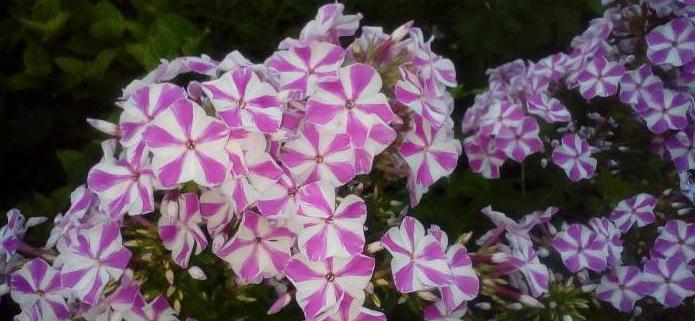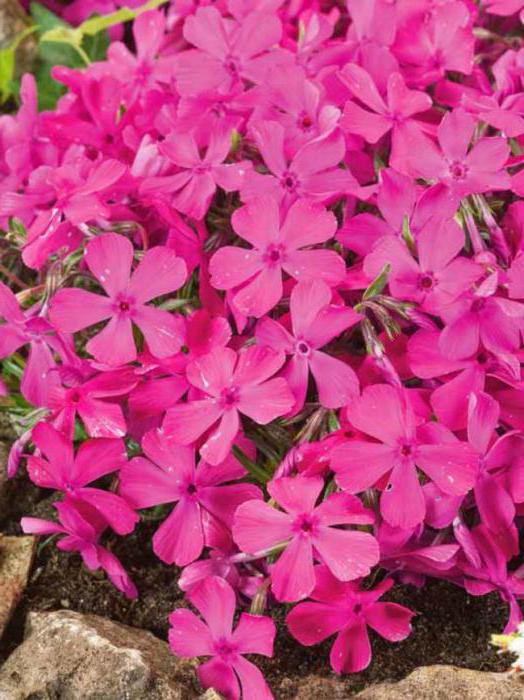Phlox - one of the best crops for growing in flower beds. The popularity of these flowers is most often associated with unpretentiousness, frost resistance, bewitching aroma and lush, bright flowering.
Phloxes are attractive for their long flowering period. If you choose the right types and varieties, this period can continue continuously from spring to autumn.
History
It was in Greece that the flower got its name. It was associated with the flame, because the progenitors of modern phlox were flowers of bright red.

Over time, breeders and in the process of hybridization were created new varieties of unexpected shapes and shades. Today, only yellow phlox does not exist.
Variety "Natasha"
Paniculate phlox "natasha" - a perennial herbaceous flower with a powerful root system. That it is the basis of the life of the plant.
Compared with the lush inflorescences, the leaves of the flower are small. They have a lance-elongated or oval shape.
The inflorescences consist of many small white flowers with lilac-crimson strokes in the center of the petals. They are columnar, dense. The height of the bush reaches 80 cm.
Phlox "Natasha" is a very popular variety. It attracts many gardeners with its unusual coloring.
Features of the choice of planting material
Do you want phlox flowers to bloom in your garden?Then the main task - the choice of high quality planting material. Experienced gardeners recommend to give preference to domestic varieties. They tolerate climate change well and are resistant to many pests and diseases.
When choosing phlox varieties, landscape should be considered.territory. Combine the plants should be in their color, height of the bushes and flowering time. Immediately considering the location of all the plants in the flowerbed, you will protect yourself from transplanting plants in the future.

Remember that planting material should be planted on the site in sufficient quantities. 10 m2 It is necessary to plant 90 tall saplings or 110 undersized.
All seedlings before planting must be carefully inspected. They must be healthy, without any damage by pests or diseases.
Ideal landing site
Phlox "Natasha" is an unpretentious plant, but to get a good result, you should follow certain rules of planting. First of all, you should choose the right place.
Lighting
Phlox "Natasha" prefers darkplaces. Overheating adversely affects the state of the root system. In addition, in sunny areas the flowers quickly fade and lose their attractiveness.
Choosing these plants, you should pay attention to the color of the inflorescence. The brighter it is, the less sunlight it needs.
The soil
Gardeners recommend planting phlox "natasha" onwell drained soils with high humus content. If in your area soils with a high content of acidity, they must be "quenched" with lime. After all, phlox does not take root on such a ground.
The best type of soil for a plant is sandy soil. Proper care, regular watering and shade will provide a chic flower bed on the garden.

Landing
Planted phlox spotted "Natasha" shouldfall or spring. The soil must be prepared in advance. It is necessary to dig a shallow hole, on the bottom of which biohumus or compost is laid. If the soil is acidic, you should add lime, if loamy - organic fertilizer and sand.
The seedling is placed in a hole and gently straighten the roots in the horizontal direction.
Planting bushes preferably at a distance of 50 cm from each other. This contributes to the proper development and functioning of the root system.
Watering
The quality of watering directly affects the development of the bush and the abundance of inflorescences. On dry days, the plant should be watered at the root once a day in the evening or in the morning. At 1 m2 1.5-2 buckets of water should be added.On average, one bush consumes about 2 liters. Water must be separated by ambient temperature. Watering flowers with cold water in hot weather, you can harm their livelihoods. From the temperature difference fragile stems often crack.
Soil care
The key to good phlox development is periodicsoil loosening. The plot should always be kept in order. We must not allow the spread of weeds, which often harm the root system of flowers. In addition, they can become a breeding ground for various diseases and illnesses.

Application of fertilizers
Many gardeners recommend regularly feeding the plant. After all, it contributes to the rapid and proper formation of the bush. For dressing use mineral and organic additives.
The best option is a mixture of phosphorus orpotassium salt with liquid manure. During the year it is recommended to fertilize phlox five times. Since May, spend the first four feeding monthly. The last time fertilizers are applied at the stage of seed formation.
Trimming and transplanting
Следует регулярно обрезать засохшие стебли и faded buds of phlox "natasha". Plant height next year will not change. Remember, in the fall you need to cover the rhizome with wooden bran, soil or peat. So prepare the bush for the winter, and protect the root from frost.
Florists also recommend replanting phlox once every five years to preserve varieties. This procedure can be performed both in spring and summer.
Wintering
In the description of phlox "natasha" it is indicated that the plantrefers to cold resistant. But many gardeners recommend to be safe. Indeed, in our climatic conditions, winters with little snow are not uncommon. In this case, frost can harm plants. The shrub is additionally wrapped with needles, leaves or straw. Winters with lots of snow have a beneficial effect on the plant.

Reproduction by seeds
After flowering in a separate box, the seeds are tied. In this case, inflorescences can pollinate only insects with a valley proboscis.
In one box on average there are three seeds. If they are not collected in time, they fall into the ground. In this way, self-seeding occurs.
Seeds are planted in special pots in early spring. For the entire period, seedlings need to dive several times due to the active growth upwards.
After the seedlings are transplanted into a greenhouse. Here the plants will get stronger, gain strength. And in March, they can be planted in open ground.
Reproduction by dividing the bush
This method of plant reproduction is the easiest and requires minimal effort.
Практически сразу же после схода снега следует dig up healthy phlox bushes. Rhizomes are well cleaned from the ground. Root cervix is determined, plexuses of the root system are separated, old woody parts are removed.
As a result, you can get several from one bushindividual parts. Each of them must have thick stems and several growth buds. Separated elements can be planted separately from each other in the previously prepared soil.
Cuttings
This is one of the ways of phlox multiplication.Carry it out before the flowering period of the plant, preferably in June. From healthy bushes cut several cuttings. The lower incision should be immediately under the first kidney. All leaflets cutting shortened or cut completely.

Cuttings preferably placed in the ground under the bank. They are watered five times a day with warm water daily. A month later, the cuttings take root and give the first shoots.
Diseases and pests: prevention and treatment
Phlox are plants that are resistant todiseases and pests. Most of the problems with this plant is associated with improper care. The main mistake - the wrong place for landing. The bad quality of the soil and the lack of useful substances also negatively affect the condition of the flower.
The most common pests and diseases include:
- Nematode.
- Spotted leaves.
- Powdery mildew.
- Alternaria
It is necessary to correctly diagnose the disease and take the necessary measures in time.












